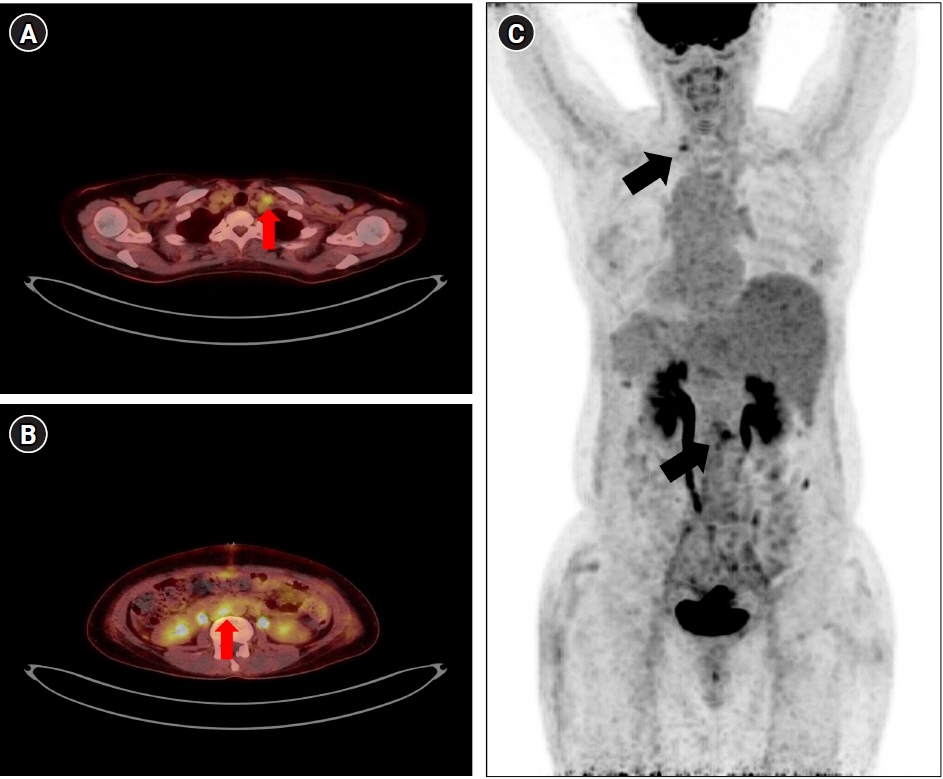Kosin Med J.
2023 Dec;38(4):293-299. 10.7180/kmj.23.146.
Selective adjuvant radiation therapy for distant lymph node metastasis in patients with stage 4B epithelial ovarian cancer: a case series
- Affiliations
-
- 1Department of Obstetrics and Gynecology, Kosin University Gospel Hospital, Busan, Korea
- 2Department of Obstetrics and Gynecology, Kosin University College of Medicine, Busan, Korea
- 3Department of Radiology, Kosin University Gospel Hospital, Busan, Korea
- 4Department of Radiology, Kosin University College of Medicine, Busan, Korea
- KMID: 2549503
- DOI: http://doi.org/10.7180/kmj.23.146
Abstract
- Although the efficacy of surgery followed by taxane- and platinum-based systemic chemotherapy has been clearly demonstrated in the standard first-line treatment of epithelial ovarian cancer, the role of radiation therapy for distant lymph node metastasis in patients with epithelial ovarian cancer is not well-established due to a lack of reported studies. We identified four patients who underwent selective adjuvant radiation therapy for neck and para-aortic lymph node lesions after primary debulking surgery between 2020 and 2022, followed by platinum-based chemotherapy for stage 4B high-grade serous ovarian cancer. Through a retrospective review of medical records, we analyzed patient clinicopathologic features, treatment course, and imaging findings. The median age was 49.25 years (range, 46–54 years). All patients had the International Federation of Gynecology and Obstetrics stage 4B disease. Following primary debulking surgery, all patients received weekly paclitaxel-carboplatin chemotherapy and maintenance treatment with poly(ADP-ribose) polymerase (PARP) inhibitors. All patients received selective adjuvant radiation therapy for neck and para-aortic lymph node metastasis before PARP inhibitor maintenance. The median follow-up time was 36.75 months (range, 19–45 months). All patients achieved a complete response. None of the patients experienced disease recurrence or died during the follow-up period. The management of distant lymph node metastasis in patients with epithelial ovarian cancer remains a matter of debate. Selective adjuvant radiation therapy in first-line treatment for ovarian cancer appears to be a feasible approach with maintenance therapy for stage 4B epithelial ovarian cancer.
Keyword
Figure
Reference
-
References
1. Baek MH, Park EY, Ha HI, Park SY, Lim MC, Fotopoulou C, et al. Secondary cytoreductive surgery in platinum-sensitive recurrent ovarian cancer: a meta-analysis. J Clin Oncol. 2022; 40:1659–70.2. Bristow RE, Tomacruz RS, Armstrong DK, Trimble EL, Montz FJ. Survival effect of maximal cytoreductive surgery for advanced ovarian carcinoma during the platinum era: a meta-analysis. J Clin Oncol. 2002; 20:1248–59.3. Harter P, Sehouli J, Lorusso D, Reuss A, Vergote I, Marth C, et al. A randomized trial of lymphadenectomy in patients with advanced ovarian neoplasms. N Engl J Med. 2019; 380:822–32.4. Ikeda Y, Yoshihara M, Tamauchi S, Yokoi A, Yoshikawa N, Kajiyama H. Survival benefits of retroperitoneal lymphadenectomy for optimally-resected advanced ovarian high-grade serous carcinoma: a multi-institutional retrospective study. J Gynecol Oncol. 2022; 33:e40.5. Hata M, Miyagi E, Koike I, Numazaki R, Asai-Sato M, Kasuya T, et al. Radiation therapy for para-aortic lymph node metastasis from uterine cervical cancer. Anticancer Res. 2015; 35:4849–54.6. Shaikh T, Churilla TM, Mantia-Smaldone GM, Chu C, Rubin SC, Anderson PR. The role of adjuvant radiation in lymph node positive endometrial adenocarcinoma. Gynecol Oncol. 2016; 141:434–9.7. Chang SJ, Hodeib M, Chang J, Bristow RE. Survival impact of complete cytoreduction to no gross residual disease for advanced-stage ovarian cancer: a meta-analysis. Gynecol Oncol. 2013; 130:493–8.8. Kehoe S, Hook J, Nankivell M, Jayson GC, Kitchener H, Lopes T, et al. Primary chemotherapy versus primary surgery for newly diagnosed advanced ovarian cancer (CHORUS): an open-label, randomised, controlled, non-inferiority trial. Lancet. 2015; 386:249–57.9. Vergote I, Trope CG, Amant F, Kristensen GB, Ehlen T, Johnson N, et al. Neoadjuvant chemotherapy or primary surgery in stage IIIC or IV ovarian cancer. N Engl J Med. 2010; 363:943–53.10. du Bois A, Baert T, Vergote I. Role of neoadjuvant chemotherapy in advanced epithelial ovarian cancer. J Clin Oncol. 2019; 37:2398–405.11. Sato S, Itamochi H. Neoadjuvant chemotherapy in advanced ovarian cancer: latest results and place in therapy. Ther Adv Med Oncol. 2014; 6:293–304.12. Rutten MJ, van de Vrie R, Bruining A, Spijkerboer AM, Mol BW, Kenter GG, et al. Predicting surgical outcome in patients with International Federation of Gynecology and Obstetrics stage III or IV ovarian cancer using computed tomography: a systematic review of prediction models. Int J Gynecol Cancer. 2015; 25:407–15.13. Raban O, Peled Y, Krissi H, Goldberg N, Aviram A, Sabah G, et al. The significance of paracardiac lymph-node enlargement in patients with newly diagnosed stage IIIC ovarian cancer. Gynecol Oncol. 2015; 138:259–62.14. Zang RY, Zhang ZY, Cai SM, Tang MQ, Chen J, Li ZT. Epithelial ovarian cancer presenting initially with extraabdominal or intrahepatic metastases: a preliminary report of 25 cases and literature review. Am J Clin Oncol. 2000; 23:416–9.15. Palluzzi E, Marchetti C, Cappuccio S, Avesani G, Macchia G, Gambacorta MA, et al. Management of oligometastatic ovarian cancer recurrence during PARP inhibitor maintenance. Int J Gynecol Cancer. 2022; 32:1164–70.16. Macchia G, Titone F, Restaino S, Arcieri M, Pellecchia G, Andreetta C, et al. Is it time to reassess the role of radiotherapy treatment in ovarian cancer? Healthcare (Basel). 2023; 11:2413.17. Narod S. Can advanced-stage ovarian cancer be cured? Nat Rev Clin Oncol. 2016; 13:255–61.18. Hong L, Qiu H, Mei Z, Zhang H, Liu S, Cao H. Ovarian cancer initially presenting with supra-clavicular lymph node metastasis: a case report. Oncol Lett. 2018; 16:505–10.19. Im SI. How to write case reports in medicine. Kosin Med J. 2022; 37:102–6.
- Full Text Links
- Actions
-
Cited
- CITED
-
- Close
- Share
- Similar articles
-
- Analysis of para-aortic lymphadenectomy up to the level of the renal vessels in apparent early-stage ovarian cancer
- The Prognosis of Patients with Stage IV Gastric Carcinoma without Distant Metastasis
- Stage IIIC epithelial ovarian cancer classified solely by lymph node metastasis has a more favorable prognosis than other types of stage IIIC epithelial ovarian cancer
- Lymph Node Metastasis in a Gynecologic Malignancy
- Prognostic Value of HSP 70 in Colorectal Cancer


